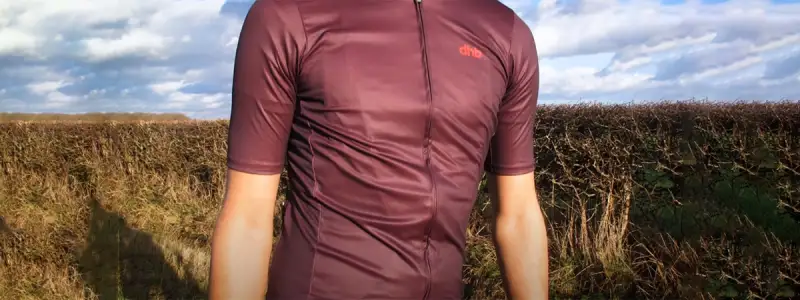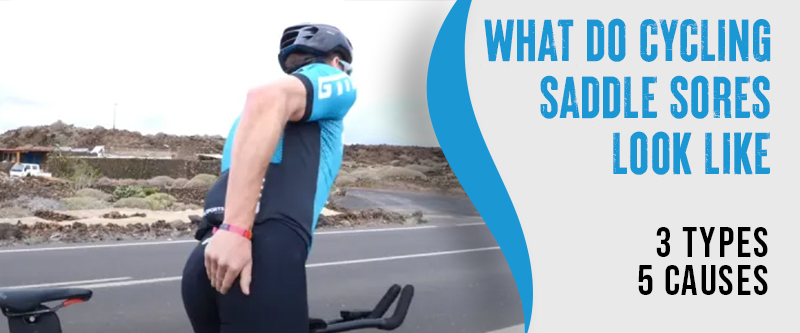Cycling saddle sores can develop from excessive friction between your cycling shorts and skin, leading to irritation and inflammation. While this may seem minor, these sores become infected over time and cause significant pain and discomfort. Saddle sores can affect your performance, affecting your ability to win or achieve your goals.
 Saddle sores while cycling can be uncomfortable and bothersome. Painful red bumps, sometimes saddle sores, can develop on your thighs and groin area. Saddle soreness and blisters can be common issues for cyclists, especially those who spend long hours on the bike. These problems can occur due to friction, pressure, and moisture in the genital area. Here are some types of cycling saddle sores:
Saddle sores while cycling can be uncomfortable and bothersome. Painful red bumps, sometimes saddle sores, can develop on your thighs and groin area. Saddle soreness and blisters can be common issues for cyclists, especially those who spend long hours on the bike. These problems can occur due to friction, pressure, and moisture in the genital area. Here are some types of cycling saddle sores:
 Saddle fitting is one of the most critical factors in preventing cycling saddle sores. An ill-fitting saddle can cause skin irritation and saddle sores. Saddles that are ill-fitted are commonly caused by:
Saddle fitting is one of the most critical factors in preventing cycling saddle sores. An ill-fitting saddle can cause skin irritation and saddle sores. Saddles that are ill-fitted are commonly caused by:

A saddle sore resembles a pimple, a mound that hurts if you press on it. Coach Peter Glassford explains it might seem like ingrown hair. Your saddle contact area, between your genitalia and your anus, is usually the location where this occurs.
This blog post will discuss what cycling saddle sores look like with their types, causes, symptoms, and prevention methods.What Do Cycling Saddle Sores Look Like: 3 Types
 Saddle sores while cycling can be uncomfortable and bothersome. Painful red bumps, sometimes saddle sores, can develop on your thighs and groin area. Saddle soreness and blisters can be common issues for cyclists, especially those who spend long hours on the bike. These problems can occur due to friction, pressure, and moisture in the genital area. Here are some types of cycling saddle sores:
Saddle sores while cycling can be uncomfortable and bothersome. Painful red bumps, sometimes saddle sores, can develop on your thighs and groin area. Saddle soreness and blisters can be common issues for cyclists, especially those who spend long hours on the bike. These problems can occur due to friction, pressure, and moisture in the genital area. Here are some types of cycling saddle sores:
Pimple-like Saddle Sores
The most common type of saddle sores that cyclists experience are pimple-like blisters. The labia, the perineum, or other high-pressure areas are common locations for them. A pus-filled sore may itch or cause discomfort when touched. Saddle sores on the labia can be a painful and frustrating for female cyclists. They are essentially irritations that can range from mild skin abrasions to more severe boils or abscesses, primarily caused by friction, pressure, and sweat during cycling.Ingrown Hair
A saddle sore caused by ingrown hair occurs when the hair grows back into the skin instead of outward. Improper shaving, hair removal methods, or tight clothing can cause it. An ingrown hair may appear as a bump or cyst on the skin, with or without pus.Chafing Saddle Sores
The skin becomes raw and irritated when it is rubbed. A chafe is irritating when the skin rubs against clothing or other material. Red sores on the skin caused by continuous rubbing are called chafing.Cycling Saddle Sores: 5 Causes
Cycling saddle sores can be a distressing and uncomfortable issue. These sores can arise from friction, heat, moisture, inadequate hygiene, or an ill-fitting saddle. By understanding and addressing these aspects, cyclists can avoid the pain and frustration associated with saddle sores.Friction
Cycling requires constant movement, causing friction between the body and the saddle. Saddle sores can result from friction-induced skin irritation. Some common causes of friction include:- Cycling shorts with a rough or abrasive texture.
- The presence of seams or tags on shorts or underwear.
Heat
Cycling generates heat, which causes the skin to sweat and creates an environment where bacteria can grow. Inflammation and skin irritation can also exacerbate saddle sores caused by excessive heat. Saddle sores caused by heat include:- Riding in hot weather.
- Overdressing in winter weather.
- A non-breathable material is worn as clothing.
Moisture
Sweat, rain, or other types of moisture can accumulate in the saddle area, creating an ideal environment for bacteria to thrive. Cycling Saddle sores and other skin irritations can result. The following factors can cause moisture-related saddle sores:- Riding in wet conditions.
- Wearing non-wicking clothing.
- Underwear that does not effectively absorb moisture.
Hygiene
Poor hygiene can also contribute to saddle sores, accumulating bacteria in the saddle area. Cleaning and drying the skin can help prevent saddle sores and other skin irritation. Poor hygiene is a common cause of cycling saddle sores:- Showering or changing clothing after riding.
- Cycling shorts and underwear that have been reused or not washed.
- The sharing of cycling equipment.
Saddle Fit
 Saddle fitting is one of the most critical factors in preventing cycling saddle sores. An ill-fitting saddle can cause skin irritation and saddle sores. Saddles that are ill-fitted are commonly caused by:
Saddle fitting is one of the most critical factors in preventing cycling saddle sores. An ill-fitting saddle can cause skin irritation and saddle sores. Saddles that are ill-fitted are commonly caused by:
- Incorrect saddle height.
- Body type-inappropriate saddle shape or style.
- The use of a harness that is too wide or too narrow.
Saddle Sores of Cycling: Symptoms & Effects
Saddle sores in cycling can be a painful experience, affecting both performance and comfort on the bike. From sharp pain and itching to redness and blisters, these skin irritations can hinder a cyclist’s ability to pedal efficiently and decrease power output.Symptoms of Saddle Sores
Symptoms of saddle sores may vary according to their severity and cause, but the following are some of the most common:- Pain: Sitting or riding long distances can cause cycling saddle sores. Pedal efficiency can be affected by sharp, burning, or throbbing pain.
- Itching: Saddle sores can also be itchy, leading to scratching and further irritation. While cycling, itchiness can interfere with our concentration and focus.
- Redness: cycling saddle sores often cause redness and inflammation around the affected area, which can be uncomfortable and embarrassing.
- Bumps or Blisters: Infected saddle sores can also appear as bumps, pimples, or blisters. It may take longer for these lesions to heal and cause more pain.
Effects of Saddle Sores
A cyclist’s performance and comfort can be negatively impacted by saddle sores.- Decrease our power output: Pedaling with saddle sores may be more difficult because you need to shift your weight or avoid putting pressure on the affected area. It can affect our pace, cadence, and climbing ability.
- Disturb our Balance and Posture: Cycling saddle sores can also make us ride awkwardly or put too much weight on one side of the bike, compromising our stability and handling. This can lead to accidents and falls.
- Lower our Motivation and Enjoyment: When cycling saddle sores recur frequently or take a long time to heal, they are demotivating and disheartening. It can also make us avoid cycling altogether, negatively affecting our fitness and social lives.
- Increase our susceptibility to Other Injuries or Infections: If cycling saddle sores are not cleaned and covered correctly, they can weaken our immune system and make us more susceptible to other infections.
The Look of Cycling Saddle Sores: 5 Prevention
Saddle sores are a common issue caused by pressure and friction during cycling. They can appear as painful bumps, blisters, or even open sores. Focusing on proper bike fit, equipment, hygiene practices, lubricants, clothing and accessory choices, and regular skin checks is crucial to prevent these discomforts. Cycling will be more comfortable with these measures.Proper Bike Fit and Equipment
Proper bike fitting prevents unnecessary friction and pressure. You can find the right fit for your bike.- Your riding style and body shape should determine the saddle’s size and condition.
- Your bike shorts should fit well, be tight, and have enough padding.
- Check the suspension, handlebars, and other components for any issues or damages that could cause discomfort on your bike. Problems that may cause distress.
Hygiene Practices
- Dry and clean your cycling shorts and saddle area.
- To avoid skin irritation, shower or bathe immediately after a ride.
- Wearing underwear underneath your cycling shorts can cause friction and chafing.
Use of Lubricants or Chamois Creams
- A lubricant or chamois cream reduces friction and prevents chafing between your skin and the saddle.
- Before riding your cycling shorts, apply lubricant or chamois cream directly to your skin.
Accessory and Clothing Options

- Wear cycling shorts made of breathable, moisture-wicking materials.
- Wear a jersey or shirt made from the same material to keep sweat from your skin.
- You should invest in cycling socks that are also moisture-wicking and breathable.
Regular Skin Checks
- Before and after a ride, check your skin for irritation or saddle sores.
- Use antibacterial ointment immediately if irritation or sores appear.
- If you notice persistent or worsening skin problems, seek medical advice.


